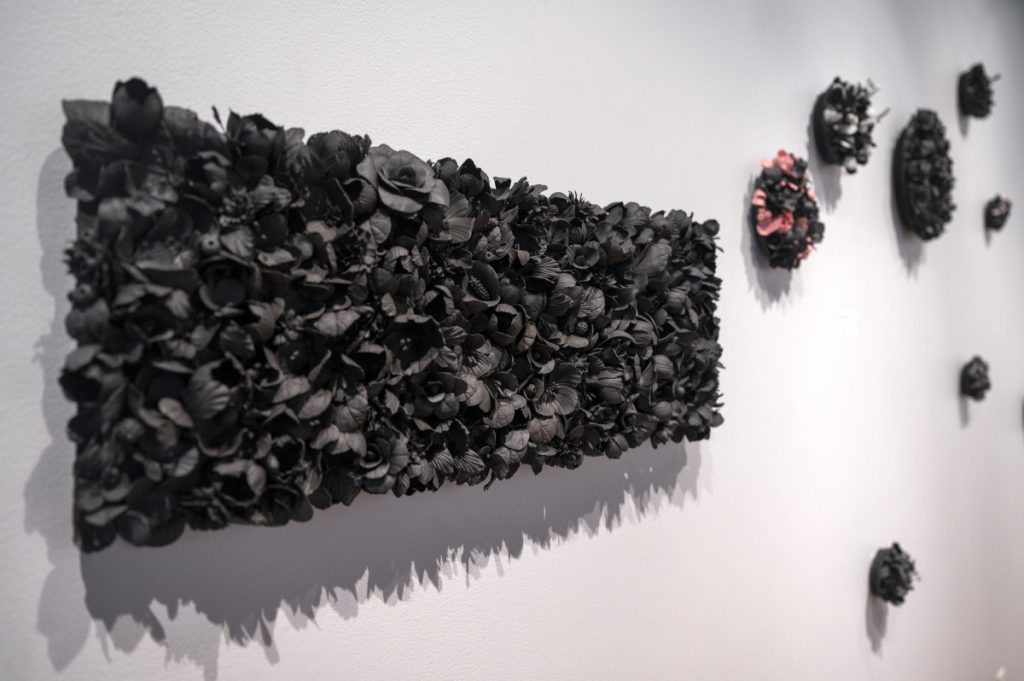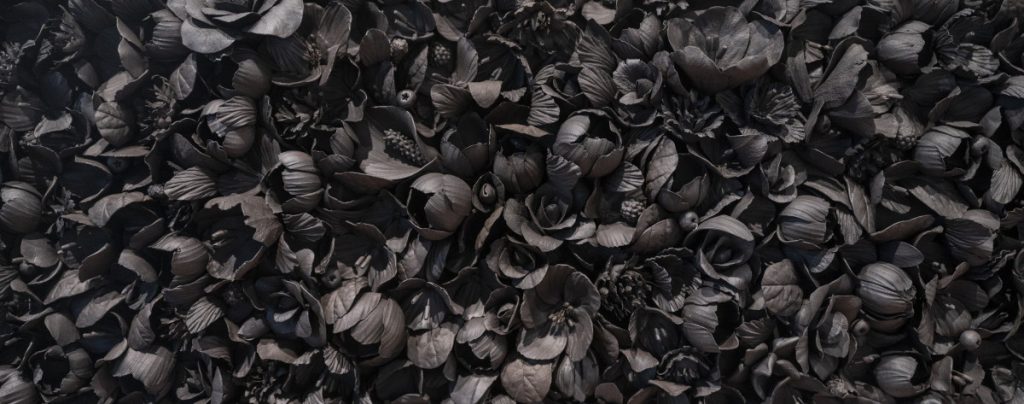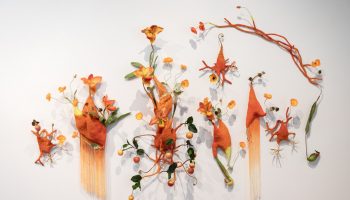Guest Critic Melissa Kuntz
The exhibition “Wallflowers” was curated by Judy Barie, the Susan and John Turben Director of CVA Galleries. Work by artist Rain Harris is displayed in the small, intimate space on the second floor of the Strohl Art Center. Harris is a sculptor and installation artist who received her Bachelor’s of Fine Arts from Rhode Island School of Design, and her Master’s of Fine Arts from Ohio State University. Her experience studying ceramics in Jingdezhen, China also informs her practice. The sculptures are all wall-hung salon style, except two on pedestals, and are hand built from porcelain and colored clays. Each consists of a collage of three-dimensional flowers of many varieties placed so closely together, sometimes overlapping, that from a distance they appear like abstracted textures. The hand-crafted petals on the flowers and leaves are detailed and paper thin. Some are all black, and others are black with one other solid color. Most are tondos, or circular, others are rectangular, square or oval. One of the largest wall pieces is 25 by 10 inches, and the smallest are six and a half inches in diameter. The flowers almost seem untamed; as if left to grow unhindered, they have densely filled in the space.
Harris states that her ideas are spurred by an interest in the ironies associated with excess and class which become interpreted visually through color, pattern and decoration. She freely borrows styles and motifs from the decorative arts and combines elements that push the limits to a point of excess. At the heart of her sculpture is an investigation of the ideas of beauty, artificiality and preciousness. She creates work that has contradictions between the tasteful and the tawdry, and good and bad taste.

Flowers are a common motif throughout the decorative and fine arts, and Harris’ flowers reference a myriad of histories. From one perspective, when comparing the wallflowers to “low” decor, the perfection of the individual flora reminds us of familiar, tawdry, artificial silk flowers. The rosettes also look a little like those used to decorate elaborate cakes. From another perspective, the works allude to the Victorian era. Victorian courtship was regimented and long, and this led to the popularity of using flowers as a secret language to communicate between lovers. Dictionaries with lists of flowers and their meanings were all the rage in Europe. A tussie mussie was a small, hand-tied bouquet given by suitors. If the recipient was pleased to receive it, she would hold it close to her heart. The round works in this exhibition are reminiscent of these bouquets of amour.
The artist mentions her inspiration from the Blaschka glass flowers, which are one of Harvard University’s most acclaimed treasures. The collection consists of 4,300 glass models that represent 780 plant species made between 1886 and 1936 by a father and son team of Czechoslovakian glass artists. The precision with which these glass flowers are crafted echoes the clay flora in Harris’ work.
Harris also references the vanitas, a style that was popular in Holland beginning in the 17th century. Vanitas artists devoted themselves to works which stressed that pleasure, wealth and beauty are fleeting and that death is certain. A common theme in vanitas works are flowers in vases, which we know will wither and die. In vanitas paintings the flowers symbolize the temporality of beauty, youth and pleasure. Harris’ all-black wallflowers also suggest death and the passage of time.

Some of my favorite works are the small round bouquets in black with a contrasting color. A black and white work consists of densely-packed black flowers with white berries and stems protruding out from the mass; the contrast is stunning. The two pieces on the pedestals, titled “Caverne Noire” and “Grotte Noir,” are organic forms, textured like rock and with cavern-like openings. The black “cave” is decorated, almost like a cake, with pink rosettes on one, and dark blue berries and leaves on the other. The juxtaposition of textures in these two works is exquisite. The larger all black wall pieces are also striking. Because they are monochromatic, the focus becomes on the shape and textures of the individual leaves and petals.
Harris’ wallflowers play off of the rich history of flowers in high and low art and culture. Her works are elegant and refined and can be appreciated for their simple beauty, but they also inspire the viewer to make their own associations and bring personal meaning to the artwork.
Pittsburgh-based Melissa Kuntz is a professor in the Department of Art at Pennsylvania Western University, Clarion. She holds a Master’s of Fine Arts and a Master’s of Arts from SUNY Purchase and a doctorate in administration and leadership through the Department of Sociology at Indiana University of Pennsylvania. She has been writing art and book reviews since 2002, for publications such as the Pittsburgh City Paper, Canadian Art magazine, The Chautauquan Daily, and Art in America magazine. Her upcoming research publications use quantitative data analysis to study the impact of race, gender, socioeconomic status and prestige of art schools on gallery representation and museum collections and exhibitions in the United States.





